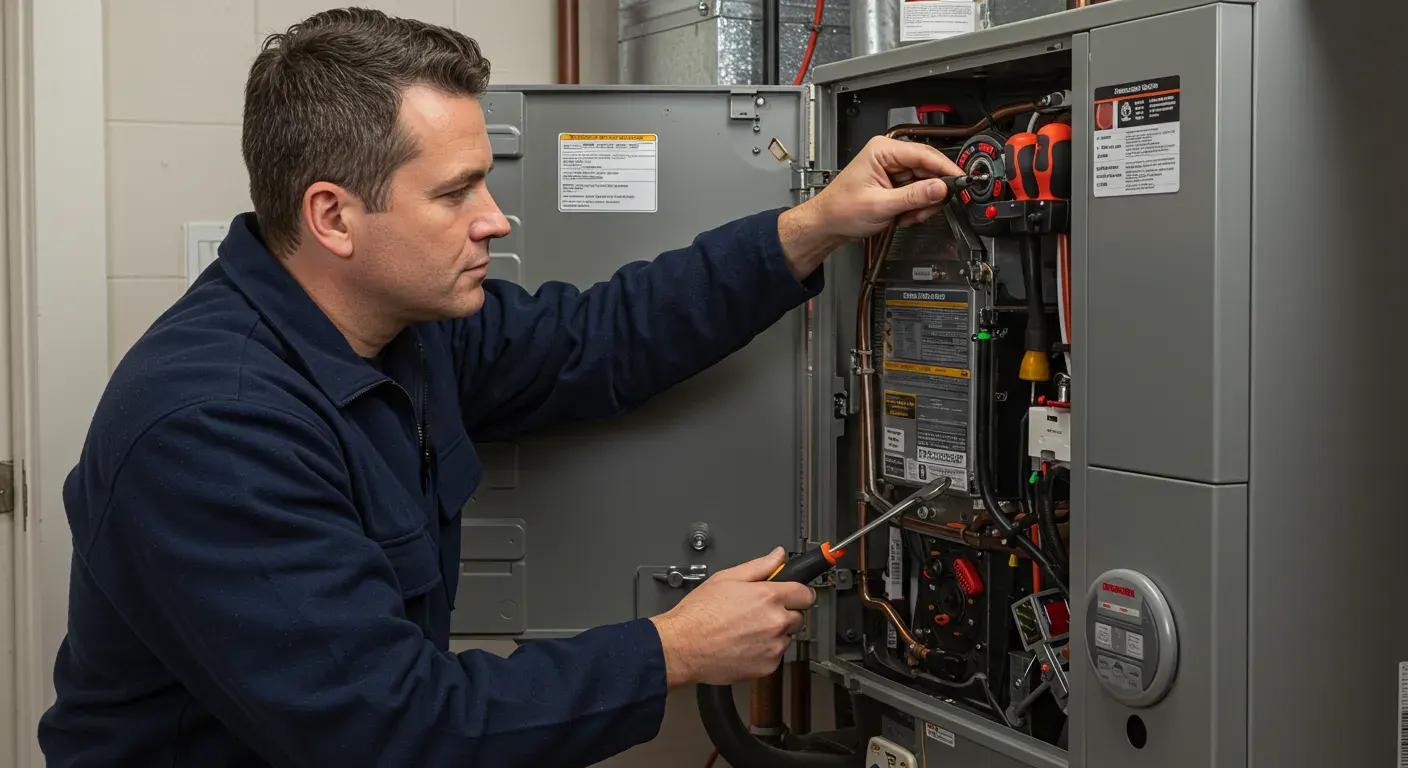
Furnace Installation in Coon Rapids, MN
A functioning furnace is essential for comfort and safety, especially during colder months. When your old heating system falters, or you’re building a new home, professional furnace installation becomes a critical decision. It’s more than just replacing a unit; it involves precise calculations, skilled execution, and adherence to safety standards to ensure your home remains warm and your energy bills stay manageable. At Stafford Home Service, we understand the complexities involved in selecting and installing the right furnace, providing a seamless and efficient process designed for lasting comfort.
Selecting the Ideal Furnace for Your Home
Choosing a new furnace is a significant investment that impacts your home's warmth, air quality, and energy consumption for years to come. Making an informed decision requires considering several key factors:
- Types of Furnaces: The primary types include natural gas, electric, and oil furnaces. Natural gas furnaces are often favored for their efficiency and lower operating costs where gas lines are available. Electric furnaces are a common choice in areas without natural gas access, while oil furnaces are less common but still used in specific regions. Each type has distinct operational characteristics and fuel considerations.
- Sizing Considerations (BTUs): The furnace's heating capacity, measured in British Thermal Units (BTUs), must precisely match your home's specific heating load. An undersized furnace will struggle to heat your home effectively, running constantly and leading to premature wear. Conversely, an oversized unit will short-cycle, frequently turning on and off, which wastes energy, creates inconsistent temperatures, and reduces the system’s lifespan. Our professionals conduct a thorough load calculation, considering factors like square footage, insulation levels, window types, and local climate, to determine the ideal BTU output for optimal performance.
- Energy Efficiency (AFUE Rating): The Annual Fuel Utilization Efficiency (AFUE) rating indicates how efficiently a furnace converts fuel into usable heat. A higher AFUE rating means less energy is wasted. Modern furnaces often boast AFUE ratings of 90% or higher, significantly reducing energy costs compared to older, less efficient models. Investing in a high-efficiency furnace can lead to substantial savings on utility bills over its lifetime.
Our experts assist you through this crucial selection process, ensuring you choose a furnace that perfectly aligns with your home’s needs and your budget.

The Professional Furnace Installation Process
Furnace installation is a meticulous process that demands expertise and precision. A properly installed system will operate safely, efficiently, and reliably for years. Here’s a general overview of the steps involved in a professional installation:
- Initial Assessment and Planning: Before any work begins, our technicians conduct a final assessment of your home and the installation site. This confirms the selected furnace's compatibility and identifies any necessary modifications to ductwork, electrical, or gas lines.
- Safe Removal of the Old Unit: The existing furnace is carefully disconnected from its fuel source, electrical connections, and ductwork, then safely removed from your property. This step includes proper disposal of the old unit, adhering to environmental regulations.
- Placement and Leveling of the New Furnace: The new furnace is precisely positioned and leveled according to manufacturer specifications and local building codes. Proper leveling is critical for efficient operation and condensate drainage.
- Ductwork Connection and Sealing: The new furnace is securely connected to your home’s existing ductwork. All connections are meticulously sealed to prevent air leaks, which can significantly reduce efficiency and lead to uneven heating.
- Gas Line and Electrical Connections: For gas furnaces, a certified technician carefully connects the gas line, ensuring all fittings are tight and leak-free. Electrical wiring is connected and tested to ensure proper power supply and safety controls are operational. For electric furnaces, high-voltage electrical connections are handled with utmost care.
- Venting System Installation or Modification: Proper venting is crucial for safely expelling combustion byproducts (like carbon monoxide) outside your home. This step involves installing or modifying the vent pipes according to furnace type and local codes, ensuring a clear and safe exhaust path.
- Thermostat Installation and Calibration: A new thermostat, often a smart or programmable model, is installed and calibrated to ensure accurate temperature control and optimize system performance.
- System Testing and Calibration: Once fully installed, the furnace undergoes comprehensive testing. This includes checking for gas leaks, verifying proper airflow, measuring temperature differentials, and calibrating all components for peak efficiency and safety.
- Homeowner Walkthrough: Our technicians will walk you through the new system, explaining its operation, maintenance requirements, and answering any questions you may have.
The Critical Role of Professional Installation
Attempting a DIY furnace installation or hiring an inexperienced contractor can lead to significant problems, compromising safety, efficiency, and potentially voiding manufacturer warranties. Professional installation ensures:
- Safety: Gas and electrical connections are complex and dangerous if mishandled. Professionals ensure all connections are secure, gas lines are leak-free, and carbon monoxide detectors are functioning, mitigating risks.
- Optimal Performance and Efficiency: Experts size the furnace correctly and install it according to manufacturer specifications, ensuring it operates at its peak efficiency, delivering consistent heating and minimizing energy waste.
- Code Compliance: Furnaces must comply with stringent local building codes and safety regulations. Professional installers are familiar with these codes and ensure your installation meets all requirements, avoiding potential fines or safety hazards.
- Warranty Preservation: Most furnace manufacturers require professional installation for their warranties to remain valid. Improper installation can void your warranty, leaving you responsible for costly repairs.
- Longevity: Correct installation reduces stress on the system, leading to fewer breakdowns and extending the overall lifespan of your furnace.
Factors Influencing Furnace Installation Investment
The total investment for a new furnace installation can vary based on several key factors, and understanding these can help you plan effectively:
- Furnace Type and Efficiency Rating: High-efficiency models with advanced features typically have a higher upfront cost but offer significant long-term savings through reduced energy consumption.
- Furnace Size (BTUs): Larger furnaces with higher BTU outputs generally cost more than smaller units.
- Ductwork Modifications: If your existing ductwork is old, damaged, or improperly sized for the new furnace, modifications or replacements will add to the overall cost.
- Venting Requirements: Changes to the venting system, especially for high-efficiency furnaces that use PVC piping, can affect installation costs.
- Complexity of Installation: Factors like accessibility to the installation site, removal of an old, unusually large, or hazardous unit, and the need for new gas or electrical lines can influence labor costs.
- Ancillary Components: The inclusion of new thermostats, air purifiers, humidifiers, or other indoor air quality accessories will impact the total investment.
Maximizing Your Furnace's Lifespan: Post-Installation Care
Once your new furnace is professionally installed, regular maintenance is key to ensuring its long-term performance and efficiency. While the initial setup is crucial, consistent care helps protect your investment:
- Routine Filter Changes: Replace or clean your furnace filter every 1-3 months, depending on usage and household conditions. A clean filter ensures proper airflow, improves indoor air quality, and prevents strain on the system.
- Annual Professional Tune-ups: Schedule yearly inspections and maintenance with a qualified technician. These tune-ups can identify minor issues before they become major problems, enhance efficiency, and extend the life of your furnace.
- Keep Vents Clear: Ensure all supply and return vents in your home are unobstructed by furniture, curtains, or rugs to allow for optimal airflow.
- Listen and Observe: Pay attention to any unusual noises, smells, or changes in heating performance. Addressing these promptly can prevent more significant repairs.
Your Trusted Partner for Furnace Installation
Investing in a new furnace is an important decision for your home's comfort and long-term energy efficiency. By choosing professional installation, you ensure that your system operates safely, optimally, and reliably for years to come. Stafford Home Service is dedicated to providing superior furnace installation services, guiding you through every step from selection to comprehensive post-installation support. Our certified technicians are equipped with the expertise and tools to deliver a flawless installation, guaranteeing your peace of mind and enduring warmth.
Ready to enhance your home's comfort and efficiency with a new furnace? Contact Stafford Home Service today to discuss your heating needs and explore your installation options.
Maintenance plan
Our premium maintenance plans start at just $216 annually, providing regular tune-ups, priority scheduling, and comprehensive protection to keep your systems running efficiently year-round.
Customer Testimonials
Our customers consistently praise our knowledgeable technicians, prompt service, and the lasting quality of the work we deliver.






